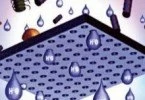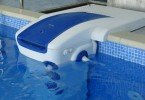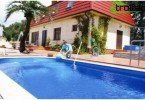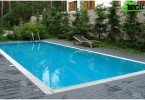Pool disinfection and cleaning
Disinfection and pool cleaning is a prerequisite for their operation. Maintaining the cleanliness of the artificial reservoir is a rather difficult and laborious task, requiring a serious attitude to the ways of solving it. Thanks to modern technology, there are many different ways to disinfect water in the pool. Cleanliness of the reservoir becomes a guarantee of safety for human health.
Content
- Ways to clean pool water
- Means for mechanical cleaning
- Chemical cleaning products
- Electrophysical pool cleaning
Ways to clean pool water
Timely use of disinfection and cleaning of the pool will avoid too frequent water changes. There are the following main methods by which the pool water is cleaned and disinfected:
- Mechanical cleaning;
- Chemical cleaning;
- Electrophysical cleaning.
Important! Only the use of a range of pool cleaning measures will help achieve maximum water safety..
Most of the events can be carried out manually, automatically or semi-automatically. The most economical, of course, is the manual cleaning option, but it is longer and more complex. The automatic version is notable for its high price, speed of the process and ease of use. It takes into account many factors that affect the quality of water, which can not always be taken into account independently. The semi-automatic option for cleaning the reservoir is a compromise between the two previous.
Means for mechanical cleaning
Mechanical cleaning of the pool is carried out by filtration. This method allows you to remove mechanical, organic impurities from water, such as dust, dirt particles, leaves, hair, insects and other small debris.
Filtration plants clean only the upper layer of water, passing it through nozzles and returning it to the pool again.
Attention! The power of the filter unit should ensure that the entire volume of water passes through the filter 3-6 times a day.
There are several types of filter systems:
- Sand filters are the most common and less expensive. The filtering elements in this installation are quartz sand, sifted in a special way, and gravel;
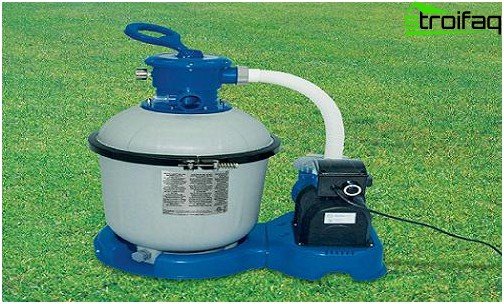
A sand filter cleans water by separating contaminants as it passes through quartz sand and gravel.
- Diatomite filters – characterized by a high degree of purification. The filtering elements are diatom sand, granite backfill;
- Cartridge filters – the easiest to use from the presented analogues.
It should be noted that the filter pump for cleaning the pool is not able to remove contaminants deposited on the walls and bottom of the artificial reservoir. This problem can be dealt with using an underwater vacuum cleaner to clean the pool. This device is a specialized unit, the purpose of which is to purify water from pollutants with a higher density.
There are several varieties of vacuum cleaners that differ in their characteristics and purpose.
Manual underwater vacuum cleaners (they are also called bottom vacuum cleaners) are of low cost and are intended for use in collapsible or inflatable pools. They are connected to the filter and clean the bottom of the pond..
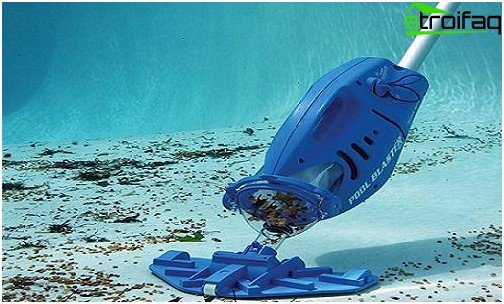
Handheld underwater vacuum cleaner versatile equipment for cleaning the walls of a reservoir and bottom
Semi-automatic vacuum cleaners allow you to clean the walls and bottom of the pool. This type of equipment is suitable for pools of various types due to its versatility. Some models of semi-automatic underwater vacuum cleaners need to be connected to the scrimmer. But there are other models that are autonomous, as the package includes a bag for collecting contaminants.
Automatic underwater vacuum cleaners are characterized by increased maneuverability, power, and are completely autonomous. The use of this type of vacuum cleaner is advisable in pools with a large area and depth. They perfectly clean the walls and bottom of the artificial pond..
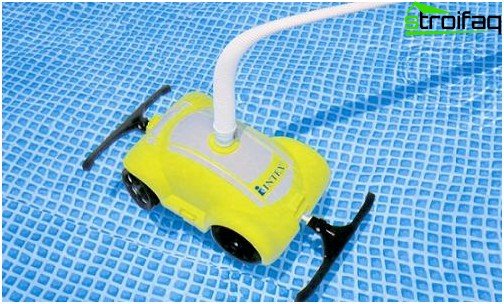
Automatic underwater vacuum cleaner guarantees quality cleaning
The advantage of underwater vacuum cleaners is the absence of additional pollution during the processing of the working surface, characteristic of the manual cleaning method. The use of these devices allows you to clean the pool and direct the resulting pollution into filter pumps or special bags.
For manual cleaning of the reservoir, you will need a whole set for cleaning the pool, which includes a variety of devices and tools. These include nets, brushes, telescopic rods. For example, a net for cleaning the pool allows you to collect debris from the surface (surface net) or from the depth of the pond (deep net).
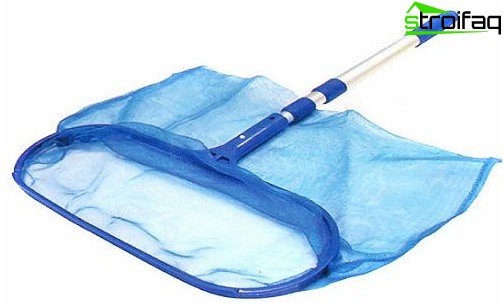
A pool cleaning net is needed to collect litter from the surface of the water
To clean the bottom, the walls of the bowl, a brush is used to clean the pool.
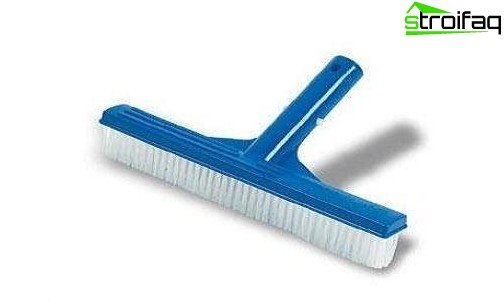
Pool cleaning brush
Of course, even the use of highly efficient equipment for mechanical treatment of water cannot replace the use of chemicals. The use of chemistry makes it possible to neutralize dangerous microorganisms that enter along with garbage and dirt.
Chemical cleaning products
Chemical cleaning of water in the pool allows you to effectively destroy biologically active pollutants, their waste products. There are various means for cleaning pools, which provide the opportunity to achieve the required water quality and carry out such an important procedure as disinfection of the pool.
It should be noted that the modern means for cleaning the pool not only purifies the water, but also prevents the appearance of harmful impurities in the reservoir.
Chemical cleaning is divided into several categories:
- Maintaining the level of Ph at the required level;
- Ensuring water disinfection by introducing specialized products (chlorine, bromine, active oxygen);
- The introduction of drugs to prevent pollution (to prevent the appearance of algae, calcareous deposits, turbidity of the water).
Modern means for the disinfection of pools in the recommended concentration are safe for human health. Timely use of chemistry makes the water clean, eliminating the need for constant replacement. The main thing is to strictly observe the instructions for the use of substances and not exceed the permissible concentration.
Preparations are available in various forms – powder, liquid substance, granules, briquettes, tablets for cleaning the pool. You can choose any suitable consistency. In addition, there are multifunctional tablets for cleaning pools that allow you to perform several tasks at once (disinfection, Ph level adjustment, removal and prevention of lime deposits and others).
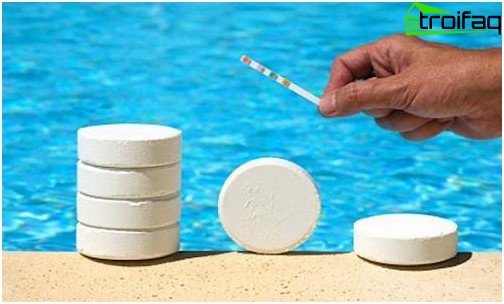
Pool disinfection tablets – a comprehensive tool that optimizes the composition, disinfecting environment and prevents the deposition of calcium
When using halogens (chlorine and bromine), pool disinfection is effective and fast. This method is optimal for disinfection of large volumes of water and is a cheap solution to this issue. Chlorine gas is more common; chlorine dioxide, hypochlorites, and chloramine are also used. When using these funds, care should be taken, since halogens are quite aggressive. Chlorination is best used in combination with other drugs..
A softer water treatment system suitable for smaller pools is active oxygen disinfection. This method is characterized by a lower speed and efficiency compared to treatment with halogens. To achieve an optimal result, the concentration of the active substance should be constantly monitored..
There is a more modern disinfection method based on electrolysis. A small amount of sodium chloride is added to the reservoir, which, when passing through the electrolysis station, decomposes into chlorine and sodium. Liquid chlorine entering the pool immediately reacts with organic pollutants. This method avoids irritation of the mucous membranes, skin.
Electrophysical pool cleaning
The use of electrophysical cleaning methods reduces the use of chemicals. This method is reagent-free, and disinfection is carried out using ozonation, ultraviolet radiation and ionization of copper and silver.
The effectiveness of ozone is much higher than that of chlorine, it is safe and does not have a harmful effect on the human body..
Ultraviolet irradiation of water is also highly effective and safe, based on the use of special lamps – UV emitters.
Water purification using copper and silver ions is carried out using specialized equipment. Contaminated water passes through electrodes under direct current. Under its influence, the electrodes are activated, resulting in the formation of silver and copper ions. These elements are characterized by effectiveness in the destruction of harmful bacteria and algae.
In conclusion, it should be noted that to achieve the best result in the process of disinfection and cleaning of pools, a whole range of special tools and equipment should be used. An important point in ensuring compliance with hygiene requirements is the regularity and timeliness of cleaning procedures. It is a multilateral approach to the issue of cleaning that will achieve the maximum level of safety and cleanliness of the artificial reservoir.


